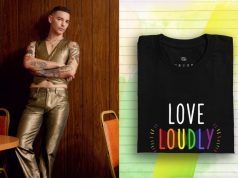LONDON — Ashleigh Talbot lives in her navy-blue Doc Martens with rainbow laces. She would rather have them in shiny purple, but the brand does not make them in a big enough size.
Talbot, a transgender woman, owns just two other pairs of shoes — blue glittery trainers and black ankle boots that she wears for her job as an administrative assistant at an arts festival in the north of England.
“I cannot buy women’s shoes on the high street,” said the 34-year-old, who wears a British size 10-11 (U.S. size 10.5-11.5).
“Even now, six years after changing my name… I’m still wearing basically the same kind of shoes that I did before.”
While transgender consumers remain a relatively niche part of the market for women’s shoes, their numbers are growing as society becomes more accepting of people who do not conform to gender norms.
Referrals to clinics that treat people with gender dysphoria, who feel their gender does not match their body, have risen 240 percent in five years in Britain, according to official data.
And statistics from the Gender Identity Research and Education Society, a British charity, suggest 1 percent of people in Britain may identify as transgender or non-binary.
Yet despite the growing demand for clothes and shoes from trans consumers, many still feel overlooked by big companies.
Most big fashion firms in Britain, such as Clarks and New Look, sell women’s shoes up to a size nine, with only a limited selection of larger sizes.
That forces many trans women to choose between more masculine styles and the hyper-sexualized designs of specialist retailers — with nothing in between.
“There’s tons of fetish sites and so on that will sell you a size 10 shoe, but they’ve got a six-inch heel,” said Natalie Washington, a 35-year-old transgender woman who works in IT.
“Trying to find nice pair of flat shoes in a size 10 that aren’t kind of really dowdy, older ladies kind of comfort shoes, that are nice and will go with nice outfits, is really, really difficult. And I haven’t managed to yet.”
Gap in the market
Things have begun to shift, with smaller retailers spotting a gap in the market.
It helps that women’s feet are getting longer and wider as people, particularly in the West, grow taller and heavier.

The average size worn by a British woman is now a size six (U.S. size eight), compared with size four in the 1980s, according to the Society of Shoe Fitters.
Banana Shoes started selling high heels imported from the United States in Rotherham, a former coal mining town in northern England, in 1999.
Soon customers were asking for larger sizes. Now, about 60 percent of their sales are a British size nine or above, ranging from the pointy-toed, fetish high heels and thigh-high glittery boots favored by drag queens to plain black court shoes.
“More shops should sell to larger sizes and I almost don’t want to tell them, because I feel like I’ve found a bit of a niche,” said Chloe Herrera Pasqualin, who took over the company from her parents-in-law last year.
“There is a market for larger-size shoes and it’s a growing market.”
More sparkles
At the mass market end, high-street stores such as H&M and Zara have responded to changing demand by launching gender-neutral clothing lines.
But some transgender women say the shapeless styles and dull colors are a turn-off.
Trans and non-binary people are “far more colorful than that,” said Talbot. “You’re not doing enough sparkles.”
Even trainers are gender-specific, with bright colors limited to smaller sizes, she said.
New York-based Syro was set up in 2016 specifically to sell high heels to men. Most of its customers buy U.S. sizes 10-12, with the most popular style a chunky-heeled black ankle boot.
A year ago it was selling 30-40 pairs of high heels a month. In January, it shipped almost double that, with no marketing other than Instagram and word of mouth.
“The bulk of our customers are queer boys who are very boyish in presentation, but who really wanted to feel a little extra, a little bit more femme,” said Shaobo Han, who co-runs the New York-based company.
For those who want to look more feminine without resorting to fetish wear, though, there is little available.
“You really don’t get what I would call a day shoe,” said Juliette Noir, a cross-dresser with size 10 feet, using her female name.
“You can’t find a good, chunky-heeled, knee-high boot… to wear on a day out.”
Herrera Pasqualin said crossdressers and trans customers “want to be able to do everything a woman can do,” she said. “They don’t want any kind of differentiation, which is totally fair enough.”
She recalled exchanging emails with a customer who was transitioning to female.
“Nothing about the conversation really changed, apart from me calling her Jenny. But she was so overwhelmed,” she said.
“It really hit home that day, actually, that this is not just a pair of shoes for some people. This is the difference between feeling like the person they feel like or feeling different.”
— Reporting by Rachel Savage; Editing by Hugo Greenhalgh and Claire Cozens, Thomson Reuters Foundation










